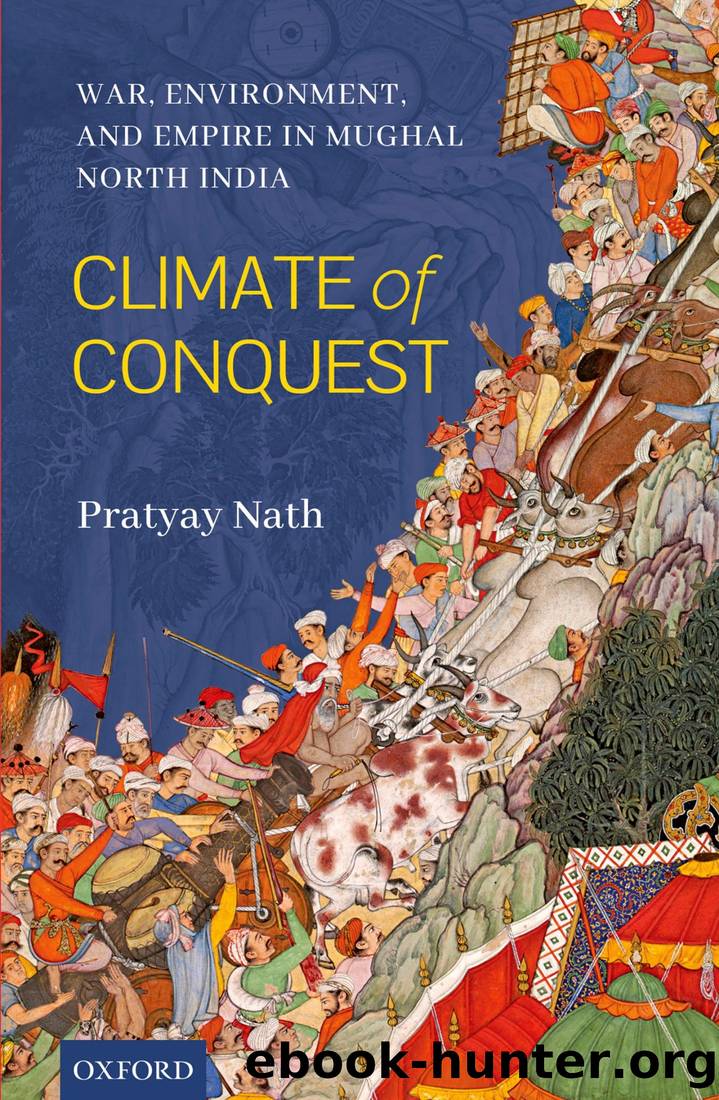Climate of Conquest: War, Environment, and Empire in Mughal North India by Pratyay Nath

Author:Pratyay Nath [Nath, Pratyay]
Language: eng
Format: epub
Tags: Military, General, history, N/A, Asia, India & South Asia
ISBN: 9780199495559
Google: TmGRxgEACAAJ
Publisher: Oxford University Press
Published: 2019-11-15T00:28:10.527551+00:00
1 Akbar was accompanied on this expedition by the Portuguese missionary Anthony Monserrate. The latter has left behind a detailed account of the journey in his travelogue. This is the main source of the information for this section. See Anthony S.J. Monserrate, The Commentary of Father Monserrate on His Journey to the Court of Akbar, 1580â1582, trans. J.S. Hoyland (New Delhi and Chennai: Asian Educational Services, 2003).
2 For the political analysis of Mirza Hakimâs career, see Munis Faruqui, âThe Forgotten Prince: Mirza Hakim and the Formation of the Mughal Empire in India,â Journal of Social and Economic History of the Orient 48, no. 4 (2005), 487â523. Also see Streusand, Formation, 154â72.
3 Monserrate, Commentary of Father Monserrate, 102â3.
4 Monserrate, Commentary of Father Monserrate, 104.
5 Monserrate, Commentary of Father Monserrate, 109. More than seven decades later, Bernier, travelling from Delhi to Kashmir with a Mughal army, crossed the Chenab over a bridge of boats. (Bernier, Bernierâs Travels in the Mughal Empire, A.D. 1656â1668, 386.)
6 Monserrate, Commentary of Father Monserrate, 109â10.
7 Monserrate, Commentary of Father Monserrate, 121â35. According to Persian sources, the imperial army first attempted to build a bridge of boats at the confluence of the Indus and the Kabul rivers, failing which they took to ferrying the troops across in boats. (AN, 3: 353â4/519; TA, 2: 359â60/548â9.)
8 John A. Lynn, ed., Feeding Mars: Logistics in Western Warfare from the Middle Ages to the Present (Boulder and Oxford: Westview Press, 1993), vii.
9 Globally, most of the existing body of literature on military logistics pertains to European history. Some of the most important works include Bernard S. Bachrach, âOn the Origins of William the Conquerorâs Horse Transportsâ, Technology and Culture 26, no. 3 (1985), 505â31; Bernard S. Bachrach, âSome Observations on Administration and Logistics of the Siege of Nicaea,â War in History 12, no. 3 (2005), 249â77 Martin van Creveld, Supplying War: Logistics from Wallenstein to Patton (Cambridge, New York, and Melbourne: Cambridge University Press, 1977); Lynn, Feeding Mars; Jonathan P. Roth, The Logistics of the Roman Army at War (264 B.C.âA.D. 235) (Leiden, Boston, and Köln: Brill, 1999); John H. Pryor, ed., Logistics of Warfare in the Age of the Crusades, (Hampshire and Burlington: Ashgate, 2006).
10 One major exception is Randolf Cooperâs work on the Anglo-Maratha wars. Randolf GS Cooper, âBeyond Beasts and Bullion: Economic Considerations in Bombayâs Military Logistics, 1803â, Modern Asian Studies 33, no. 1 (1999), 159â83; Randolf GS Cooper, The Anglo-Maratha Campaigns and the Contest for India (New Delhi: Foundation Books Pvt. Ltd, 2005). Some work has been done on the roads of the Mughal Empire. See Abul Khair Muhammad Farooque, Roads and Communications in Mughal India (Delhi: Idarah-i Adabiyat-i Delli, 1977); Subhash Parihar, Land Transport in Mughal India: The LahoreâAgra Highway (New Delhi: Aryan Books International, 2008).
11 Gommans, Mughal Warfare, 67â130.
12 De la Garza, The Mughal Empire at War, 157â81.
13 Spilling beyond the realm of military labour, this rich corpus of work also contributes to our understanding of Mughal political economy. Important works include Ali, The Mughal Nobility under Aurangzeb; M.
Download
This site does not store any files on its server. We only index and link to content provided by other sites. Please contact the content providers to delete copyright contents if any and email us, we'll remove relevant links or contents immediately.
Kathy Andrews Collection by Kathy Andrews(11733)
The remains of the day by Kazuo Ishiguro(8828)
Paper Towns by Green John(5092)
Spare by Prince Harry The Duke of Sussex(5074)
Industrial Automation from Scratch: A hands-on guide to using sensors, actuators, PLCs, HMIs, and SCADA to automate industrial processes by Olushola Akande(4988)
The Body: A Guide for Occupants by Bill Bryson(4976)
Machine Learning at Scale with H2O by Gregory Keys | David Whiting(4190)
Be in a Treehouse by Pete Nelson(3952)
Never by Ken Follett(3796)
Harry Potter and the Goblet Of Fire by J.K. Rowling(3775)
Goodbye Paradise(3729)
Into Thin Air by Jon Krakauer(3314)
The Remains of the Day by Kazuo Ishiguro(3295)
The Cellar by Natasha Preston(3263)
The Genius of Japanese Carpentry by Azby Brown(3226)
Fairy Tale by Stephen King(3220)
120 Days of Sodom by Marquis de Sade(3184)
The Man Who Died Twice by Richard Osman(2997)
Drawing Shortcuts: Developing Quick Drawing Skills Using Today's Technology by Leggitt Jim(2996)
